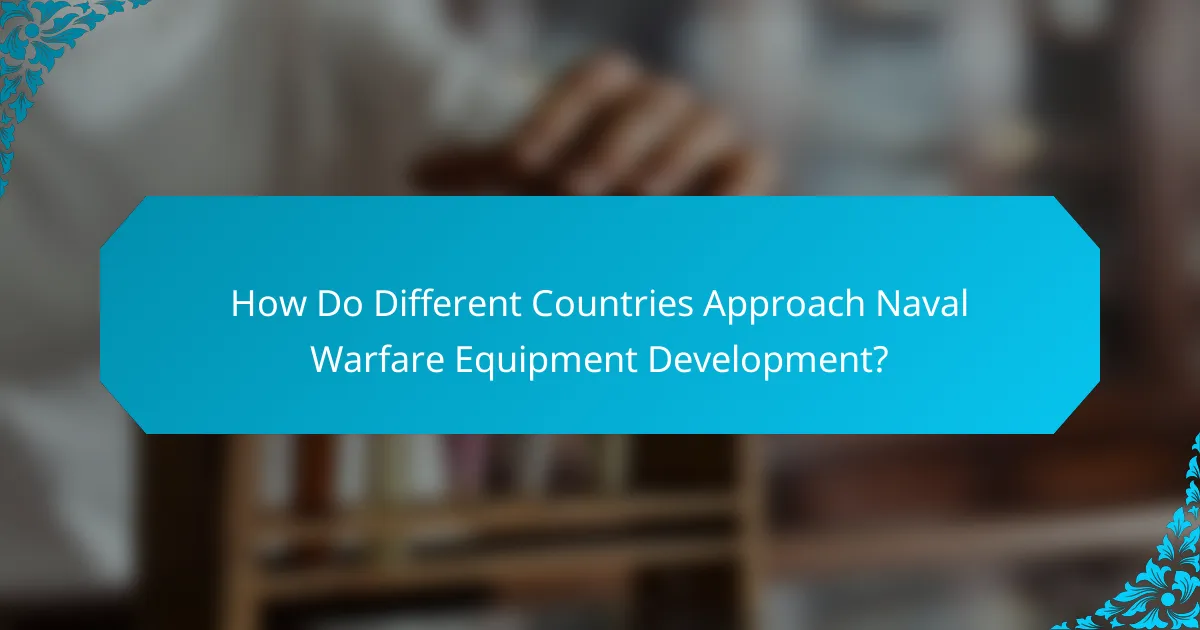Innovations in naval warfare equipment are revolutionizing the way naval forces operate, emphasizing efficiency, combat effectiveness, and strategic superiority. With advancements such as unmanned systems, cutting-edge weaponry, and sophisticated cyber tools, modern navies are better equipped to navigate the complexities of contemporary warfare, fundamentally altering tactical and operational strategies.

What Are the Latest Innovations in Naval Warfare Equipment?
The latest innovations in naval warfare equipment focus on enhancing operational efficiency, increasing combat effectiveness, and improving strategic capabilities. Key advancements include unmanned systems, advanced weaponry, and cyber tools that reshape naval engagements.
Unmanned Aerial Vehicles (UAVs)
Unmanned Aerial Vehicles (UAVs) have revolutionized naval operations by providing real-time surveillance, reconnaissance, and strike capabilities without risking crewed aircraft. These drones can operate in hostile environments, gathering intelligence and conducting missions with precision.
Modern naval UAVs, such as the MQ-4C Triton, can fly long distances and stay airborne for extended periods, often exceeding 24 hours. Their ability to relay high-definition imagery and data enhances situational awareness for naval commanders.
Advanced Missile Systems
Advanced missile systems, including hypersonic and precision-guided munitions, significantly increase the lethality of naval forces. These systems can strike targets at unprecedented speeds and accuracy, making traditional defenses less effective.
For example, hypersonic missiles can travel at speeds greater than Mach 5, complicating interception efforts. Navies are investing in these technologies to maintain a strategic edge and deter potential adversaries.
Cyber Warfare Tools
Cyber warfare tools are becoming essential in naval operations, allowing forces to disrupt enemy communications, navigation, and weapon systems. These tools can be used for both offensive and defensive strategies, enhancing overall mission success.
Naval forces must continuously update their cyber capabilities to protect against evolving threats. Regular training and simulations help personnel stay prepared for potential cyber incidents that could impact operational readiness.
Stealth Technology
Stealth technology is crucial for modern naval vessels, enabling them to operate undetected in contested environments. This technology reduces radar cross-section and minimizes noise, making ships harder to target.
Examples include the Zumwalt-class destroyers, which feature a unique hull design and advanced materials to enhance stealth. Incorporating stealth into naval strategies allows for surprise attacks and improved survivability in hostile waters.
Artificial Intelligence Integration
Artificial Intelligence (AI) integration in naval warfare equipment enhances decision-making and operational efficiency. AI systems can analyze vast amounts of data quickly, providing actionable insights for commanders in real-time.
Naval forces are exploring AI applications in areas such as threat detection, autonomous navigation, and logistics. Embracing AI can streamline operations and improve response times, ultimately leading to more effective mission outcomes.

How Do Technological Advances Impact Naval Strategy?
Technological advances significantly reshape naval strategy by enhancing capabilities, improving decision-making, and adapting to new forms of warfare. These innovations allow navies to operate more effectively in complex environments, ultimately influencing tactical and operational planning.
Enhanced Situational Awareness
Enhanced situational awareness is achieved through advanced sensors, satellite communications, and data fusion technologies. These tools provide real-time information about enemy movements, environmental conditions, and friendly forces, allowing for more informed tactical decisions.
For example, modern naval vessels utilize radar and sonar systems that can detect threats at greater distances and in various conditions. This capability reduces response times and increases the likelihood of successful engagements.
Improved Decision-Making Processes
Technological innovations streamline decision-making processes by integrating artificial intelligence and machine learning into naval operations. These systems analyze vast amounts of data quickly, identifying patterns and suggesting optimal courses of action.
Naval commanders can leverage these insights to make timely decisions, reducing the risk of human error. Training personnel to effectively use these technologies is crucial for maximizing their potential in high-pressure situations.
Increased Operational Range
Advancements in propulsion systems and weaponry have significantly increased the operational range of naval forces. Modern ships can operate farther from their home ports, extending their reach and influence in global waters.
For instance, submarines equipped with advanced missile systems can strike targets hundreds of kilometers away, allowing for strategic deterrence without direct engagement. This capability shifts the dynamics of naval power projection.
Adaptation to Asymmetric Warfare
Technological advances enable navies to adapt to asymmetric warfare, where conventional forces face unconventional threats. Innovations such as unmanned systems and cyber capabilities allow for flexible responses to non-traditional adversaries.
Navies must develop strategies that incorporate these technologies to counter threats from smaller, agile forces. This includes investing in counter-drone systems and enhancing cybersecurity measures to protect critical infrastructure.

What Are the Key Components of Modern Naval Warfare Equipment?
Modern naval warfare equipment comprises various advanced technologies designed to enhance maritime combat effectiveness. Key components include naval vessels, submarines, weapons systems, and surveillance systems, each playing a critical role in contemporary naval strategy.
Naval Vessels
Naval vessels are the backbone of any navy, serving multiple roles from combat to logistics. These ships can range from aircraft carriers, which project air power, to destroyers and frigates, designed for surface warfare and defense. The choice of vessel type often depends on mission requirements, such as anti-submarine warfare or amphibious operations.
Modern naval vessels are equipped with advanced radar and missile systems, enabling them to engage targets at long ranges. For example, the integration of Aegis Combat Systems allows for simultaneous tracking and targeting of multiple threats, enhancing operational flexibility.
Submarines
Submarines are crucial for stealth operations and strategic deterrence. They can operate undetected beneath the surface, making them ideal for intelligence gathering and surprise attacks. Modern submarines often feature advanced sonar systems and torpedoes, allowing them to engage surface ships and other submarines effectively.
Nuclear-powered submarines offer extended operational ranges and endurance, making them a formidable asset in naval warfare. Countries like the United States and Russia invest heavily in submarine technology, emphasizing stealth and advanced weaponry to maintain a tactical advantage.
Weapons Systems
Weapons systems in modern naval warfare include a variety of missile types, naval guns, and close-in weapon systems. Missiles such as cruise missiles and anti-ship missiles provide long-range strike capabilities, while naval guns serve for surface engagements and support operations.
The effectiveness of these systems often depends on integration with other naval assets, such as aircraft and surveillance systems. For instance, the use of precision-guided munitions can significantly enhance strike accuracy, reducing collateral damage and increasing mission success rates.
Surveillance Systems
Surveillance systems are essential for situational awareness and threat detection in naval operations. These systems include radar, sonar, and satellite technologies that provide real-time data on enemy movements and environmental conditions.
Modern navies utilize integrated surveillance networks to share information across platforms, enhancing decision-making and response times. Effective surveillance can prevent surprise attacks and improve the overall effectiveness of naval operations, making it a critical component of maritime strategy.

What Are the Challenges in Adopting New Naval Technologies?
Adopting new naval technologies presents several challenges, including budget constraints, integration issues, training requirements, and regulatory compliance. These factors can significantly impact the effectiveness and speed of implementing advanced systems in naval operations.
Budget Constraints
Budget constraints are a primary challenge in adopting new naval technologies. Many naval forces operate under tight fiscal limitations, which can restrict the acquisition of cutting-edge equipment. For instance, the costs associated with research, development, and procurement can easily reach millions of USD, making it difficult to justify new investments.
To manage budget constraints effectively, naval organizations often prioritize technologies that promise the highest return on investment. This means focusing on systems that enhance operational efficiency or provide significant strategic advantages, even if they require upfront capital.
Integration Issues
Integration issues arise when new technologies must work seamlessly with existing systems. Many naval vessels are equipped with legacy systems that may not be compatible with modern innovations, leading to operational inefficiencies. For example, integrating advanced radar systems with older ships can require extensive modifications.
To mitigate integration challenges, naval forces should conduct thorough compatibility assessments before procurement. This can involve pilot programs or phased rollouts to ensure that new technologies can be effectively integrated into existing frameworks without disrupting operations.
Training Requirements
Training requirements are crucial for the successful adoption of new naval technologies. Personnel must be adequately trained to operate and maintain advanced systems, which can be time-consuming and costly. Training programs may need to be developed from scratch, especially for highly specialized equipment.
Naval organizations can address training challenges by investing in simulation-based training tools. These tools allow personnel to gain hands-on experience without the risks associated with live operations, thereby reducing the time and cost of training while improving readiness.
Regulatory Compliance
Regulatory compliance is another significant challenge when adopting new naval technologies. Various international and national regulations govern the use of military equipment, which can complicate the procurement process. Compliance with standards, such as those set by NATO or the International Maritime Organization, is essential to ensure interoperability and safety.
To navigate regulatory compliance effectively, naval forces should engage with legal and regulatory experts early in the technology adoption process. This proactive approach helps identify potential compliance issues and streamline the acquisition of new technologies, ensuring that all necessary approvals are obtained in a timely manner.

How Do Different Countries Approach Naval Warfare Equipment Development?
Countries vary significantly in their approach to developing naval warfare equipment, influenced by factors such as strategic needs, budget constraints, and technological capabilities. Each nation’s naval strategy shapes its investment in equipment, leading to diverse innovations and advancements.
United States
The United States focuses on advanced technology and multi-domain operations, emphasizing stealth, automation, and network-centric warfare. Investments in unmanned systems, such as drones and autonomous vessels, are key to enhancing operational capabilities.
For example, the U.S. Navy’s Zumwalt-class destroyers feature advanced stealth technology and integrated combat systems, allowing for greater versatility in various combat scenarios. The budget for naval equipment development often exceeds tens of billions of USD annually, reflecting the priority placed on maintaining naval superiority.
China
China’s approach to naval warfare equipment development is characterized by rapid modernization and expansion of its naval fleet. The country invests heavily in aircraft carriers, submarines, and missile systems to assert its influence in regional waters.
China’s Type 055 destroyers and Type 001 aircraft carriers represent significant advancements in naval capabilities, showcasing a shift towards blue-water operations. The Chinese government allocates substantial resources, with defense spending often reported in the range of hundreds of billions of CNY, to support this growth.
Russia
Russia emphasizes a combination of traditional naval power and asymmetric warfare strategies, focusing on submarines and anti-access/area denial (A2/AD) capabilities. The development of advanced submarines, such as the Borei-class, highlights Russia’s commitment to maintaining a formidable underwater presence.
Investment in naval equipment is often influenced by geopolitical tensions, with budgets fluctuating based on the current political climate. Russia’s naval modernization efforts are supported by a defense budget that typically ranges in the tens of billions of RUB, reflecting its strategic priorities.
European Nations
European countries generally adopt a collaborative approach to naval warfare equipment development, often through NATO partnerships and joint programs. Nations like the United Kingdom and France focus on maintaining a balanced naval force that includes both surface ships and submarines.
The UK’s Queen Elizabeth-class aircraft carriers and France’s Barracuda-class submarines exemplify this collaborative spirit, with shared technologies and operational strategies. Defense budgets across Europe vary, with many countries investing several billion EUR annually to enhance their naval capabilities.



